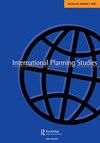高速铁路对萎缩城市轨迹的影响:以日本北部新干线网络的延伸为例
IF 1.5
Q4 REGIONAL & URBAN PLANNING
引用次数: 1
摘要
摘要随着越来越多的国家人口减少,高铁(HSR)向周边地区不断缩小的城市延伸,这再次引发了关于高铁基础设施影响的争论。日本就是这样,该国继续扩大其高度发达的高铁网络,希望遏制地区衰退。本文通过考察新干线网络对日本北部岩手县和青森县五个市镇的影响,研究了高铁是否对周边地区连接的中小城市的收缩轨迹产生了积极影响。尽管在一些案例研究中人口减少的速度有所放缓,但研究结果强调,高铁并没有扭转收缩,其好处主要体现在可及性的增加上,尽管分布不均。这表明,新干线并没有统一提升社会经济前景,而是有助于重塑连接城市的轨迹,并在区域层面再现核心-外围动态。本文章由计算机程序翻译,如有差异,请以英文原文为准。
The impact of high-speed rail on the trajectories of shrinking cities: the case of the extension of the Shinkansen network in northern Japan
ABSTRACT As more countries witness depopulation, the expansion of High-Speed Rail (HSR) to reach shrinking cities in peripheral regions is renewing the debate on the effects of this infrastructure. This is the case in Japan, a country that continues to extend its highly developed HSR network hoping to curb regional decline. This paper investigates whether HSR had a positive effect on the shrinking trajectories of connected medium and small-sized cities in peripheral regions by examining the impact of extending the Shinkansen network on five municipalities in the prefectures of Iwate and Aomori, northern Japan. Although depopulation decelerated in some of the case studies, the findings highlight that HSR did not reverse shrinkage and benefits are mainly found in increased accessibility, albeit unevenly distributed. This suggests that, rather than uniformly uplifting socio-economic outlooks, the Shinkansen contributed to reshaping the trajectories of the connected cities and reproduced core–periphery dynamics at the regional level.
求助全文
通过发布文献求助,成功后即可免费获取论文全文。
去求助
来源期刊

International Planning Studies
REGIONAL & URBAN PLANNING-
CiteScore
4.60
自引率
4.80%
发文量
20
期刊介绍:
Planning, at urban, regional, national and international levels, faces new challenges, notably those related to the growth of globalisation as both an objective socio-economic process and a shift in policy-maker perceptions and modes of analysis. International Planning Studies (IPS) addresses these issues by publishing quality research in a variety of specific fields and from a range of theoretical and normative perspectives, which helps improve understanding of the actual and potential role of planning and planners in this context.
 求助内容:
求助内容: 应助结果提醒方式:
应助结果提醒方式:


